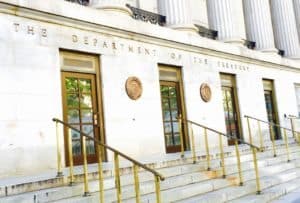As traditional lending tightened for consumers and small businesses, following the 2008 recession and the Dodd Frank regulatory environment that followed, alternative lending has now become quite the burgeoning new industry. And with alternative lenders ranging the gamut from near-bank products and terms to deep sub-prime or payday, it has become difficult for consumers and commercial borrowers to make sense of their options, and secure the right financing to meet their needs.
 Consumer protection regulation has increased somewhat dramatically in the consumer space in recent years, but this has not yet carried over to small business lending. Now, this isn’t to say that small business lenders are not operating under quite a bit of regulation. In fact, the small business lenders of today are actively working with the SEC, FINRA, the FTC and state regulators in all 50 states.
Consumer protection regulation has increased somewhat dramatically in the consumer space in recent years, but this has not yet carried over to small business lending. Now, this isn’t to say that small business lenders are not operating under quite a bit of regulation. In fact, the small business lenders of today are actively working with the SEC, FINRA, the FTC and state regulators in all 50 states.
But as alternative lending becomes more and more robust, with the recent IPOs of Lending Club and OnDeck, as well as a number of recent securitizations backed by assets originated by Marketplace Lenders, a number of regulatory agencies seem to now be asking themselves.;
“Shouldn’t we know more about this lending landscape?”
“Marketplace Lending” is a relatively new phenomenon and buzz-phrase in the small business financing landscape, but the “Online Marketplace Lending” landscape also tends to be quite confusing to Main Street America. In order to protect small business owners (SMBs), it is important for online lenders to be defined within some form of segmentation, and since the motivations differ between them, each segmentation should ultimately have its own set of best practices.
 Among the agencies that have historically weighed in on consumer lending, the U.S. Department of the Treasury, in an attempt to bring clarity to the alternative online lending industry, recently issued a Request for Information (RFI) about “Online Marketplace Lending.” Since the Treasury is not a body that issues regulation outright, it is thought among many lenders that this RFI is the first step in a path to a much larger conversation, and potentially with a number of other agencies. Whether this discussion results in increased regulation for small business lending is still unsure, but it is important that leading players in the space participate.
Among the agencies that have historically weighed in on consumer lending, the U.S. Department of the Treasury, in an attempt to bring clarity to the alternative online lending industry, recently issued a Request for Information (RFI) about “Online Marketplace Lending.” Since the Treasury is not a body that issues regulation outright, it is thought among many lenders that this RFI is the first step in a path to a much larger conversation, and potentially with a number of other agencies. Whether this discussion results in increased regulation for small business lending is still unsure, but it is important that leading players in the space participate.
As an introduction to the RFI, the Treasury issued a rather broad definition for the “Marketplace Lending,” stating that it is:
“the segment of the financial services industry that uses investment capital and data-driven online platforms to lend either directly or indirectly to small businesses and consumers.”
It then explains:
“Companies operating in this industry tend to fall into three general categories: (1) Balance sheet lenders…; (2) online platforms (formerly known as “Peer to Peer” or “P2P”)…; and (3) bank-affiliated online lenders…”
While alternative online lenders do generally share the characteristic of lacking a brick and mortar presence with which to interact with their customers, it is important to spend time differentiating models, as each “type” of “Marketplace Lender” has a differing business model, with varying revenue streams and diverse motivations in serving their customers. At Dealstruck, we believe that the small business borrower should know and understand these important differentiators.
Some Definitions
As a “balance sheet lender,” Dealstruck provides term loans and lines of credit to SMBs on our own balance sheet, which has been funded by venture capital, hedge funds and other institutional investors. We take credit risk on every loan that we fund.
As a “balance sheet lender,” our financial performance is directly affected by the performance of the the loans we originate, and as such, we are motivated to be prudent in our credit decisions. The success of our business depends on our ability to manage credit risk.
While we do utilize technology to manage our process more efficiently, our lending process is similar to lending practices that have been operating for decades preceding us.
If “balance sheet” is akin to traditional lending, then “Peer to Peer” or “P2P” is similar to traditional brokering. While P2P lenders do underwrite to some extent, they ultimately hand off the transaction, and the credit risk, to another investor. Their business model is largely dependent upon origination, creating an incentive for volume.
The meaning of “Sub-prime” and opening access to capital to a new borrower population
It is next important to differentiate between “sub-prime” borrowers and the rest of the borrower population. The “sub-prime borrower” definition has slowly become an umbrella term that spans a broad array of the credit spectrum.
 The biggest successes in “Marketplace Lending” have generally created little overall impact for the “sub-prime,” or underserved borrower. The bulk of lending in the consumer space, namely with Lending Club and Prosper, has saved the borrower money, but not granted access to credit that was not otherwise available. If a consumer has a FICO score of 660 and a debt-to-income ratio of less than 25%, they are generally able to access credit from traditional sources as well as Marketplace Lenders.
The biggest successes in “Marketplace Lending” have generally created little overall impact for the “sub-prime,” or underserved borrower. The bulk of lending in the consumer space, namely with Lending Club and Prosper, has saved the borrower money, but not granted access to credit that was not otherwise available. If a consumer has a FICO score of 660 and a debt-to-income ratio of less than 25%, they are generally able to access credit from traditional sources as well as Marketplace Lenders.
In an effort to provide access to the underserved borrower, some models, including those of OnDeck, Capital Access Network, have identified both the opportunity and need to reach below the prime credit spectrum.
Within this “sub-prime” umbrella, however, has also been buried a mid-prime market, which can be served with a more specialized and affordable product.
At Dealstruck, we, along with Fundation, Funding Circle, and other lenders, generally serve this “mid-prime” market, which includes SMBs who are not eligible for traditional bank financing. These borrowers are typically left with very limited, high-cost options. We are able to provide a reasonably-priced product to this group of borrowers with the end goal of graduating them into a bankable product within the term of their financing with us.
By taking a finer-toothed comb to the “sub-prime” market, we have found that high quality businesses have been massively underserved and mispriced, and thus deserve a product set that is more “bank-like,” more affordable, and properly priced and sized.
The use of technology to assess credit risk and the importance of “humans” in underwriting
 As the portfolios among online lenders grow, we are better able to utilize data, analytics techniques and risk modeling to evaluate the profiles of businesses that are higher risk, so that we can better detect stressors on the business before an adverse event.
As the portfolios among online lenders grow, we are better able to utilize data, analytics techniques and risk modeling to evaluate the profiles of businesses that are higher risk, so that we can better detect stressors on the business before an adverse event.
However, a risk may arise in relying solely upon third party electronic data sources. As lenders, we try to curb overconfidence in a data model that has not yet withstood the test of time. While Marketplace Lenders use a number of electronic data sources to assist us in triangulating borrower information in our underwriting process, nearly every lending operation we’ve seen still requires staffing and communication with the borrower, and fraud detection procedures depend upon our human review of tax returns, making phone calls, doing site visits, and reconciling bank statements to financial statements. Data, while extremely useful in building efficiency and scale, hasn’t yet replaced human interaction.
We have been active in building out best practices within our industry since our inception, and we intend to offer a full response to the US Treasury RFI in the coming weeks, but do see a number of important themes arising from this inquiry, and happy to participate in this important conversation about expanding access to capital for SMBs.
To this end, I encourage others in our industry to join the “best practice” discussion as well. Dealstruck recently signed the Borrower’s Bill of Rights, which outlines how we, as industry leaders, can take the first step in building transparency and fairness into the alternative lending landscape. Please join us in advocating for the borrower’s best interests.
 Candace Klein is Chief Strategy Officer at Dealstruck. She is an attorney with experience as a small business owner. Candace was founder and CEO of Bad Girl Ventures. She received her BA from Northern Kentucky University and her JD from the Salmon P. Chase College of Law. She continues to serve as General Counsel for Women Investing in Women, a global NGO focused on increasing access to capital for female entrepreneurs and access to capital markets for female investors.
Candace Klein is Chief Strategy Officer at Dealstruck. She is an attorney with experience as a small business owner. Candace was founder and CEO of Bad Girl Ventures. She received her BA from Northern Kentucky University and her JD from the Salmon P. Chase College of Law. She continues to serve as General Counsel for Women Investing in Women, a global NGO focused on increasing access to capital for female entrepreneurs and access to capital markets for female investors.


